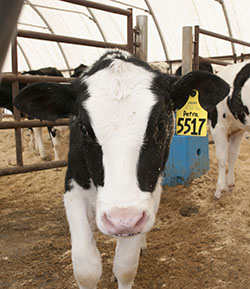 "SNP chips are information powerhouses," says Tami Smith with Neogen Corporation. Smith addressed the audience at the Dairy Calf and Heifer Association's annual conference last week.
"SNP chips are information powerhouses," says Tami Smith with Neogen Corporation. Smith addressed the audience at the Dairy Calf and Heifer Association's annual conference last week.A SNP (pronounced snip) is short for single-nucleotide polymorphism, or a genetic variation in DNA due to the sequence of nucleotides. Through genomic testing, we can learn more about these differences and the genetic make-up of an individual animal.
There are four main ways to use genomics on the farm, Smith said. One is to confirm parentage. She has seen farms with 2 to 3 percent of animals misidentified, all the way up to 40 percent. "Genomics can help clarify that," she noted.
Another reason is to make earlier culling decisions. AgStar estimates show it costs about $2,000 to raise a dairy replacement. Therefore, a heifer will need to produce about 32,000 pounds of milk and will likely be in her second lactation before turning any profit, Smith explained.
"Knowing as much as you can know about animals when they cost you the most helps you prepare for changes in the market," Smith explained. Genomic data can help identify animals that may not become productive adults and gives farms an opportunity to cull before incurring all the rearing costs.
Other on-farm uses of genomic testing include mate selection and identification of elite cows, Smith noted.
The best time to do genomic testing depends on your farm's animal handling abilities, she said. If you are going to test all animals, testing early is better because you can make culling decisions sooner.
If you wait a few months, you could do a visual assessment of size and health and a records appraisal before genomic testing. Then, you may have a better idea of what animals you want to test and could be more selective, she said. If you test on the day of birth, you won't know anything about health, performance or environmental effects on the animal yet.
"How you use your data can change from year to year," Smith said, depending on milk price, feed price and your own farm situation. No matter how it's used, she does believe that there is room for growth in the benefit genomics provides on farms in the future.

The author is an associate editor and covers animal health, dairy housing and equipment, and nutrient management. She grew up on a dairy farm near Plymouth, Wis., and previously served as a University of Wisconsin agricultural extension agent. She received a master's degree from North Carolina State University and a bachelor's from University of Wisconsin-Madison.









